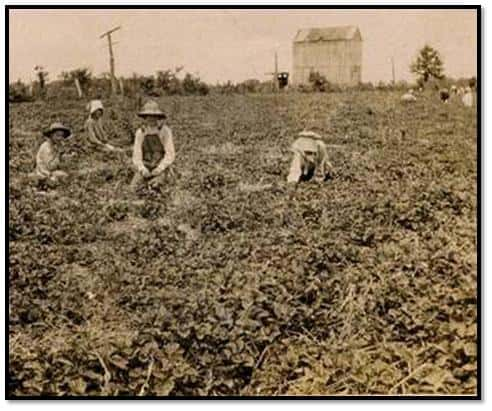When Strawberry Was King
Written by Justin Lamb

Strawberry pickers on the Van Tyree Farm in Harvey preparing crates to go to market in Paducah in the 1930s.
(Courtesy of Johnnie Riley Davis)
Nothing says summer quite like the sweet taste of a good homegrown strawberry. Many years ago during the mid-20th Century, strawberries were a profitable cash crop in western Kentucky which allowed the area to become known as the strawberry capital of the world due to the high volume of strawberry shipments that went through the area each year.
A record $500,000 worth of strawberries were shipped through Paducah by the year 1941, and ten years later, the statewide strawberry industry was estimated at $3 million annually. Many Marshall County farmers were active in growing the delicious fruit as far back as 1906 with the crop’s height coming in the 1940s.
Barger and Golighty, a Paducah produce firm, opened a shipping shed for loading fresh strawberries on the north side of Benton beginning in 1932 as Benton became the loading point for a large portion of the region’s strawberry. The berries were loaded into crates in route to Paducah either via the railroad depot at Benton or by independent carload shippers who crisscrossed the county loading up crates of berries to take to market.
The two most popular varieties of strawberries grown in Marshall County where “Dixie Aroma” and “Tennessee Beauties.” As the industry continued to grow, Benton resident Charlie Cone was crowned “King of Kentucky Strawberry Growers” in 1949 at the Kentucky State Horticulture Society meeting in Louisville after he shipped a whopping 422 crates of Tennessee Beauties during the 1949 season.
Each year, farmers would hire numerous pickers to harvest the crop and many transient workers would arrive each year to pick especially during the Depression years when work and money were very hard to come by. Benton resident Johnnie Riley Davis often recalls stories her father John Riley, who farmed on the south end of present day Merrywood subdivision, would tell about the days of hiring strawberry pickers on his farm: “Dad grew strawberries throughout the mid-1900s and would hire mostly the same pickers every year,” Davis recalled. “Dad used to tell the story about the big meal my grandmother cooked every day for the transient workers and one of the workers would always feed most of his food to the cats because he couldn’t get used to eating such a good meal since most of the time meals were very hard to come by for him.”

Strawberry pickers on the Van Tyree farm on Slickback Road.
(Courtesy of Johnnie Riley Davis)
As the industry grew each year, the entire county took part in the harvesting of strawberries as schools would excuse students from class to go to the fields to pick berries. Many of the county’s youth would pick strawberries in order to raise funds for a new dress or new suit just in time for the annual Big Singing Day held the last weekend in May. Children worked hard picking the berries with the only occasional complaint from farmers being that “more strawberries were ending up in the kids’ mouths instead of the baskets.”
Following the construction of Kentucky Dam in 1945 and the completion of the chemical plants that followed in Calvert City, Marshall County moved from a predominantly agricultural economy to one based more on manufacturing and tourism. Consequently, the strawberry industry began to decline in the county and never again saw the peak it once enjoyed during its glory days when strawberries were the king fruit of Marshall County.